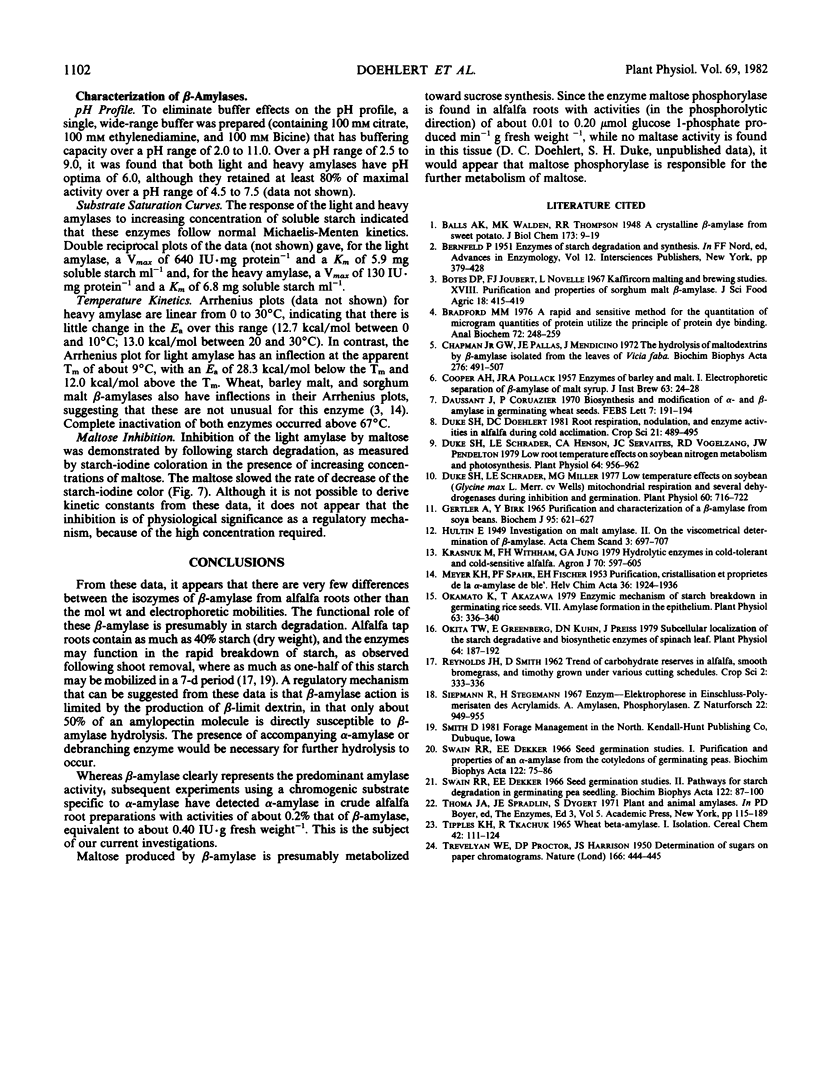Abstract
Amylase was found in high activity (193 international units per milligram protein) in the tap root of alfalfa (Medicago sativa L. cv. Sonora). The activity was separated by gel filtration chromatography into two fractions with molecular weights of 65,700 (heavy amylase) and 41,700 (light amylase). Activity staining of electrophoretic gels indicated the presence of one isozyme in the heavy amylase fraction and two in the light amylase fraction. Three amylase isozymes with electrophoretic mobilities identical to those in the heavy and the light amylase fractions were the only amylases identified in crude root preparations. Both heavy and light amylases hydrolyzed amylopectin, soluble starch, and amylose but did not hydrolyze pullulan or β-limit dextrin. The ratio of viscosity change to reducing power production during starch hydrolysis was identical for both alfalfa amylase fractions and sweet potato β-amylase, while that of bacterial α-amylase was considerably higher. The identification of maltose and β-limit dextrin as hydrolytic end-products confirmed that these alfalfa root amylases are all β-amylases.
The pH optimum for both β-amylase fractions was 6.0. Both light and heavy β-amylases showed normal Michaelis-Menten kinetics, with soluble starch as substrate, and had respectively Km values of 5.9 and 6.8 milligrams starch per milliliter and Vmax of 640 and 130 international units per milligram protein. Arrhenius plots indicated that the energy of activation for the heavy β-amylase remained relatively unchanged (12.7 to 13.0 kilocalories per mole) from 0 to 30°C, whereas the energy of activation for the light amylase increased from 12.0 to about 28.0 kilocalories per mole at 8.7°C as temperature was lowered. The light amylase was shown to be inhibited by maltose.
Full text
PDF






Images in this article
Selected References
These references are in PubMed. This may not be the complete list of references from this article.
- Bradford M. M. A rapid and sensitive method for the quantitation of microgram quantities of protein utilizing the principle of protein-dye binding. Anal Biochem. 1976 May 7;72:248–254. doi: 10.1016/0003-2697(76)90527-3. [DOI] [PubMed] [Google Scholar]
- Chapman G. W., Jr, Pallas J. E., Jr, Mendicino J. The hydrolysis of maltodextrins by a -amylase isolated from leaves of Vicia faba. Biochim Biophys Acta. 1972 Aug 28;276(2):491–507. doi: 10.1016/0005-2744(72)91010-8. [DOI] [PubMed] [Google Scholar]
- Daussant J., Corvazier P. Biosynthesis and modifications of alpha- and beta-amylases in germinating wheat seeds. FEBS Lett. 1970 Apr 2;7(2):191–194. doi: 10.1016/0014-5793(70)80154-5. [DOI] [PubMed] [Google Scholar]
- Duke S. H., Schrader L. E., Henson C. A., Servaites J. C., Vogelzang R. D., Pendleton J. W. Low root temperature effects on soybean nitrogen metabolism and photosynthesis. Plant Physiol. 1979 May;63(5):956–962. doi: 10.1104/pp.63.5.956. [DOI] [PMC free article] [PubMed] [Google Scholar]
- Duke S. H., Schrader L. E., Miller M. G. Low Temperature Effects on Soybean (Glycine max [L.] Merr. cv. Wells) Mitochondrial Respiration and Several Dehydrogenases during Imbibition and Germination. Plant Physiol. 1977 Nov;60(5):716–722. doi: 10.1104/pp.60.5.716. [DOI] [PMC free article] [PubMed] [Google Scholar]
- GERTLER A., BIRK Y. PURIFICATION AND CHARACTERIZATION OF A BETA-AMYLASE FROM SOYA BEANS. Biochem J. 1965 Jun;95:621–627. doi: 10.1042/bj0950621. [DOI] [PMC free article] [PubMed] [Google Scholar]
- Okamoto K., Akazawa T. Enzymic Mechanism of Starch Breakdown in Germinating Rice Seeds: 8. Immunohistochemical Localization of beta-Amylase. Plant Physiol. 1979 Aug;64(2):337–340. doi: 10.1104/pp.64.2.337. [DOI] [PMC free article] [PubMed] [Google Scholar]
- Okita T. W., Greenberg E., Kuhn D. N., Preiss J. Subcellular localization of the starch degradative and biosynthetic enzymes of spinach leaves. Plant Physiol. 1979 Aug;64(2):187–192. doi: 10.1104/pp.64.2.187. [DOI] [PMC free article] [PubMed] [Google Scholar]
- Siepmann R., Stegemann H. Enzym-Elektrophorese in Einschluss-Polymerisaten des Acrylamids. A. AMYLASEN, Phosphorylasen] (Ger) Z Naturforsch B. 1967 Sep;22(9):949–955. [PubMed] [Google Scholar]
- Swain R. R., Dekker E. E. Seed germination studies. I. Purification and properties of an alpha-amylase from the cotyledons of germinating peas. Biochim Biophys Acta. 1966 Jul 6;122(1):75–86. doi: 10.1016/0926-6593(66)90092-0. [DOI] [PubMed] [Google Scholar]
- Swain R. R., Dekker E. E. Seed germination studies. II. Pathways for starch degradation in germinating pea seedlings. Biochim Biophys Acta. 1966 Jul 6;122(1):87–100. doi: 10.1016/0926-6593(66)90093-2. [DOI] [PubMed] [Google Scholar]
- TREVELYAN W. E., PROCTER D. P., HARRISON J. S. Detection of sugars on paper chromatograms. Nature. 1950 Sep 9;166(4219):444–445. doi: 10.1038/166444b0. [DOI] [PubMed] [Google Scholar]



